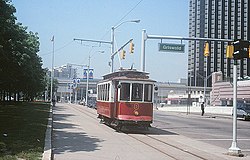In November 2021, the Detroit City Council approved plans to construct a new State Fair Transit Center, housed inside the disused Dairy Cattle Building, one of the last remaining structures from the State Fairgrounds. [14] The Council rejected a prior plan, which called for the historic building's demolition. [15] The original State Fair Transit Center, dating back to the streetcar era, closed permanently on November 6, 2022, and was promptly demolished; a temporary transit center was constructed in the former State Fair parking lot, 500 feet to the north, entering service the next day. [16] [17] [18] Construction began on the new permanent transit center in May 2023. [19] [20] [21]
The new State Fair Transit Center is dedicated to the memory of DDOT bus driver Jason Hargrove, who advocated for better protections for DDOT drivers during the early days of the COVID-19 pandemic. Hargrove died in April 2020 from COVID-19, and the transit center was dedicated in his memory in March 2024. The Jason Hargrove Transit Center opened on May 11, 2024. [22]
"Reimagined" network overhaul
In the summer of 2022, DDOT announced DDOT Reimagined, a project to redesign the agency's route network and upgrade its infrastructure for better reliability, better coverage, more efficient travel, and reduced environmental impact. The plan's first phase, conducted that summer, consisted of public outreach to gather riders' input, through in-person and virtual meetings, workshops and pop-ups at popular bus stops. [23] [24]
In Spring 2023, DDOT launched the second phase of Reimagined, which included a draft of the planned redesign. [23] The draft plan called for every route in the system to run at least every 30 minutes (where many currently run hourly), with more popular routes operating at 15-minute headways. Six routes – 3, 4, 6, 7, 9, & 10 – were slated for service every ten minutes (with route 4 running every 7½), and upgrades resembling bus rapid transit. These six, plus four other routes, would run 24/7 under this plan, with all other routes in the system running from 4 a.m. to 1 a.m., seven days a week. [25]
To achieve this plan, three of the system's least-used routes – 12, 40, & 46 – were recommended for discontinuation, while four others – 23 & 39, 29 & 42 – would be combined into two resulting routes. Other routes would be rerouted, with some seeing extensions: of note was a proposed extension of route 17 into Livonia, a neighboring community which opts out of the suburban SMART system. A new route (70) was also proposed, planned to run near the Detroit Riverfront, connecting Belle Isle with the Gordie Howe International Bridge. [25]
DDOT states that the planned redesign would mean 99% of regular riders would live within walking distance of a DDOT route, though the planned rerouting eliminates service on a number of streets. The agency conducted another series of outreach events to gauge riders' opinion, with a mobile exhibit, inside a converted bus, making a two-month tour of the system's major hubs. [24]
In August 2023, DDOT's director, C. Mikel Oglesby, resigned. G. Michael Staley, then DDOT's paratransit manager, was appointed by Mayor Mike Duggan to replace Oglesby in an interim capacity. [26] Staley previously served as a regional vice president at Veolia Transport, now known as Transdev. [27]
DDOT published the final version of the Reimagined plan in February 2024. Most of the draft plan was kept, though public input influenced a couple of major changes: route 2 was added to the routes slated for service every 10 minutes, route 12 is no longer slated for discontinuation, and the extension of route 17 into Livonia was cancelled. [28] Throughout the spring of 2024, DDOT will conduct further public outreach to gather feedback on the plan.








